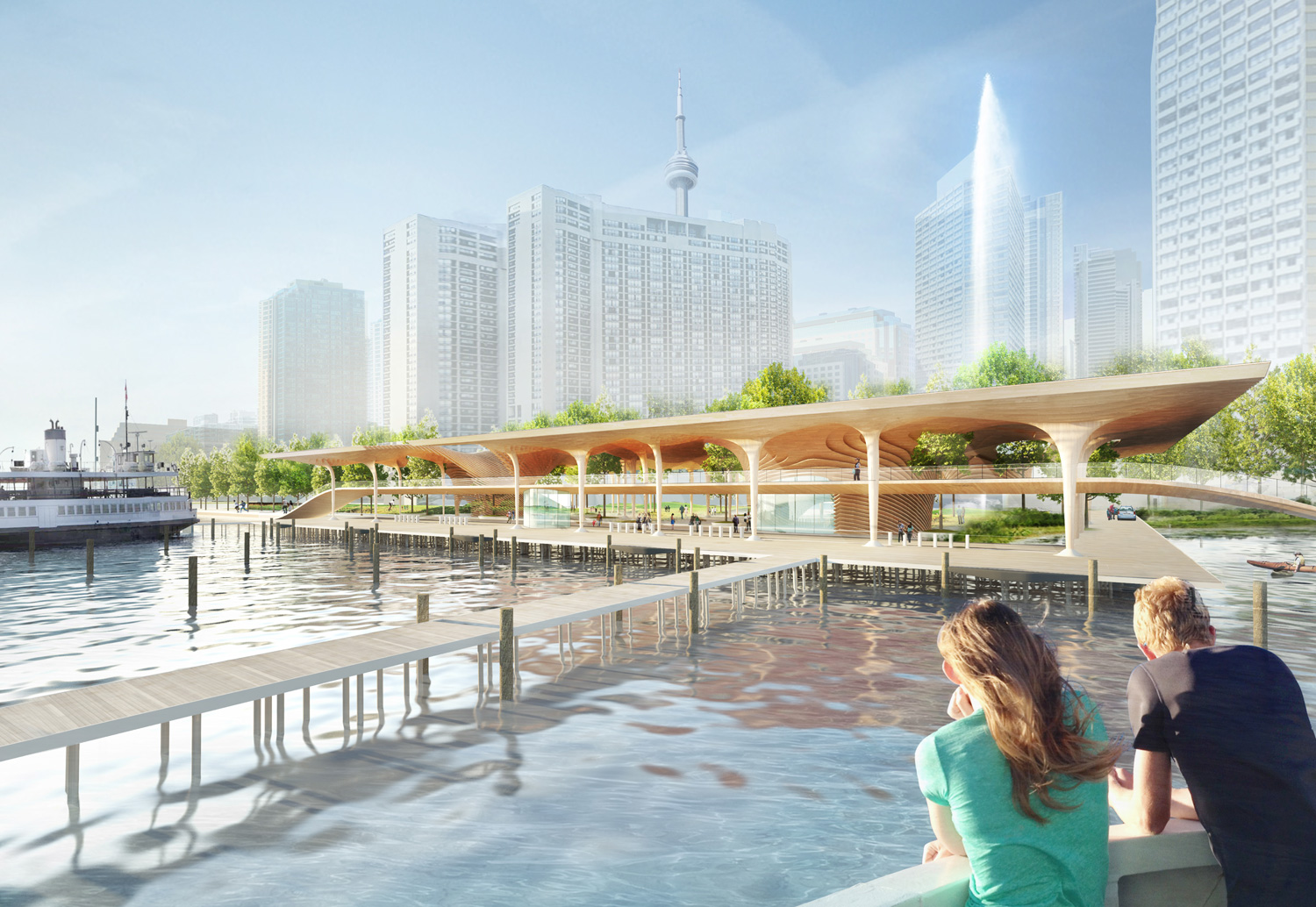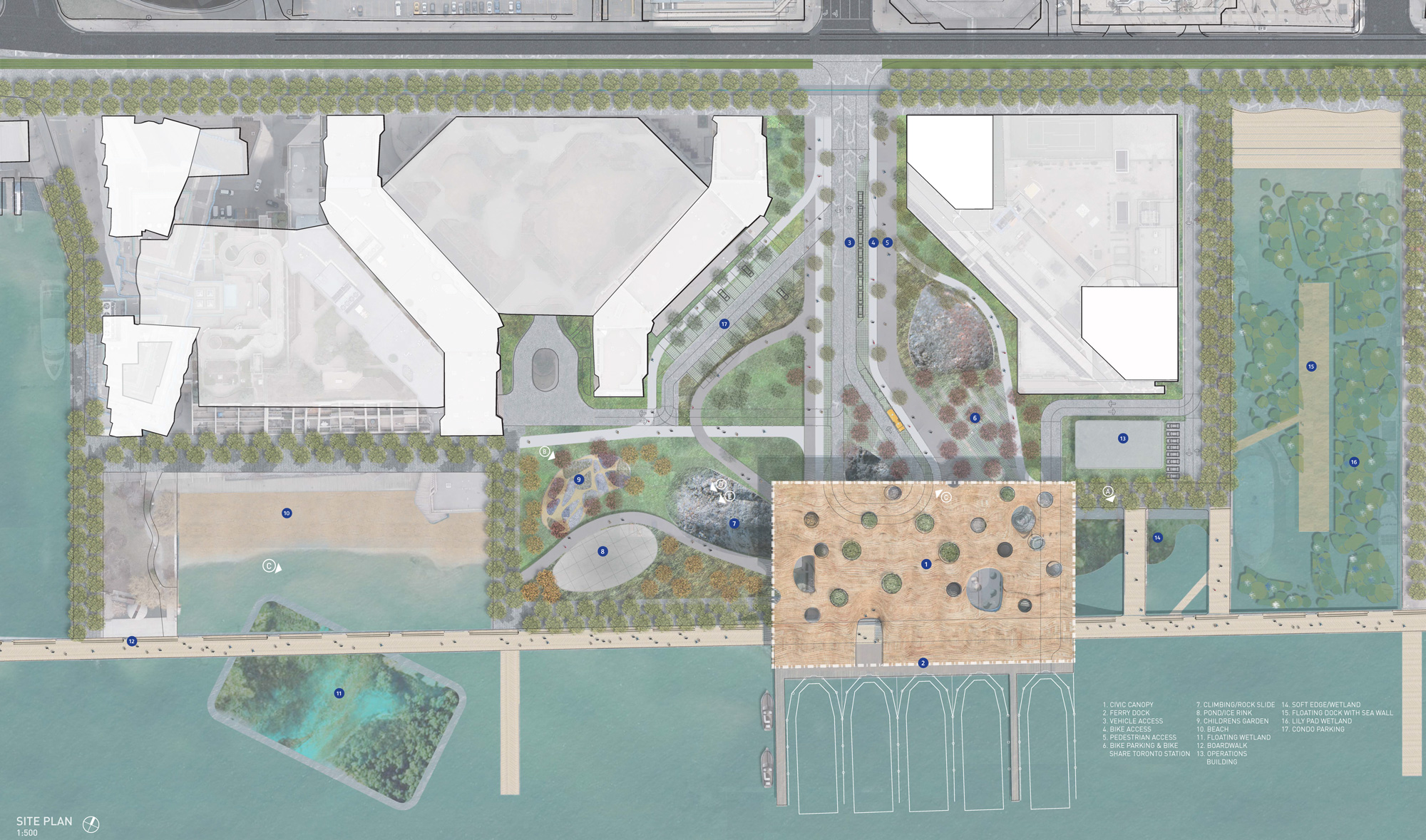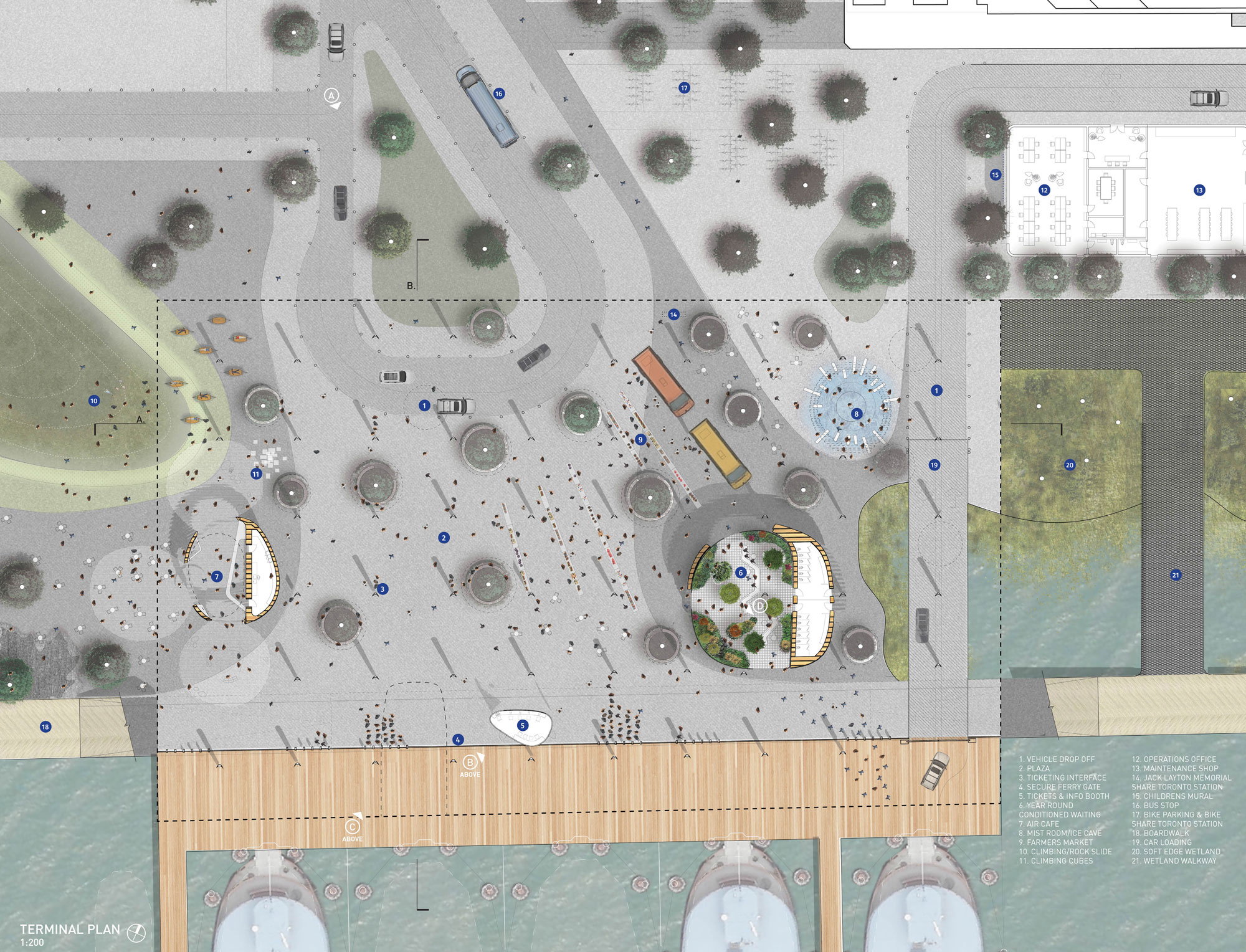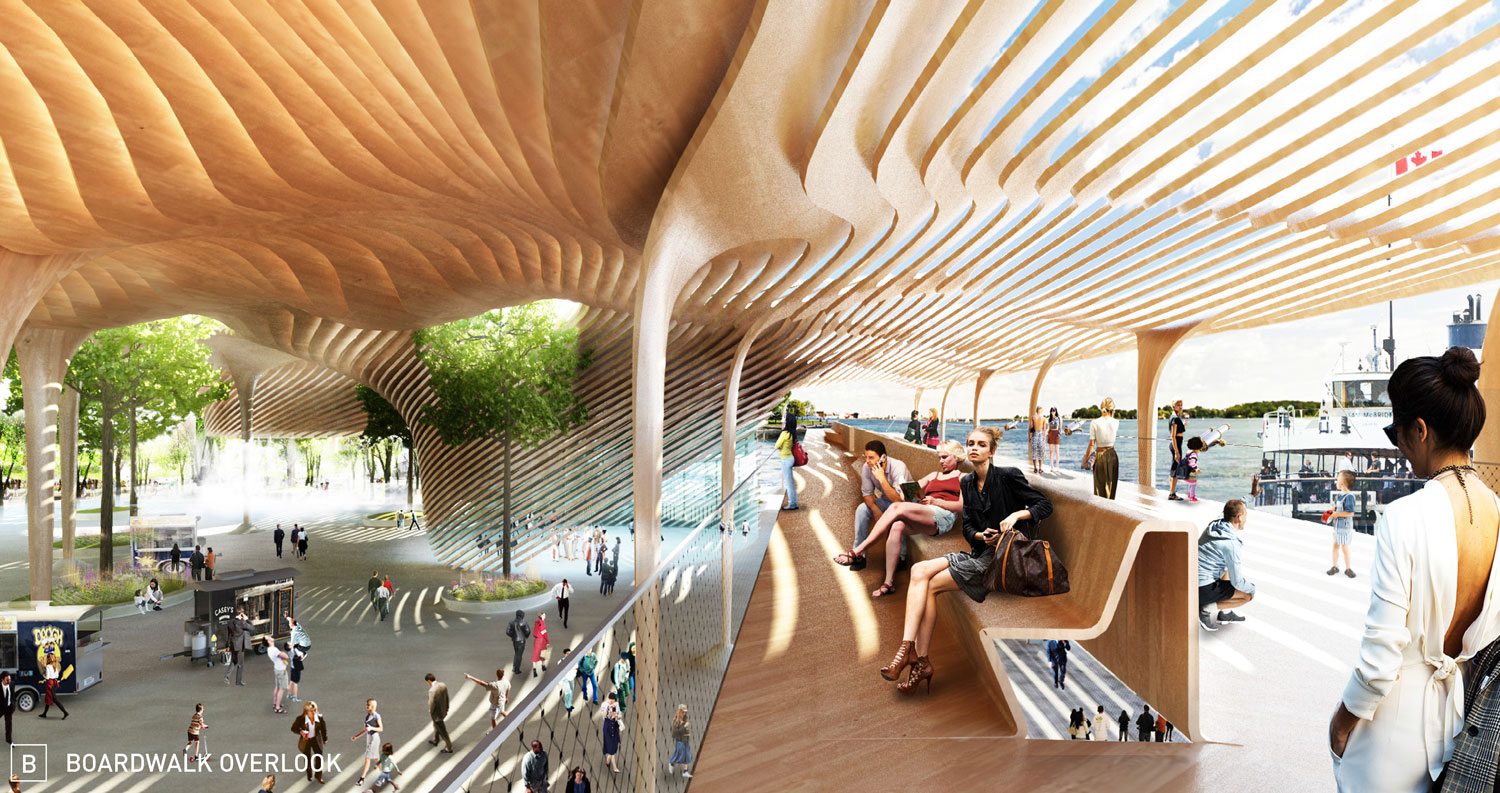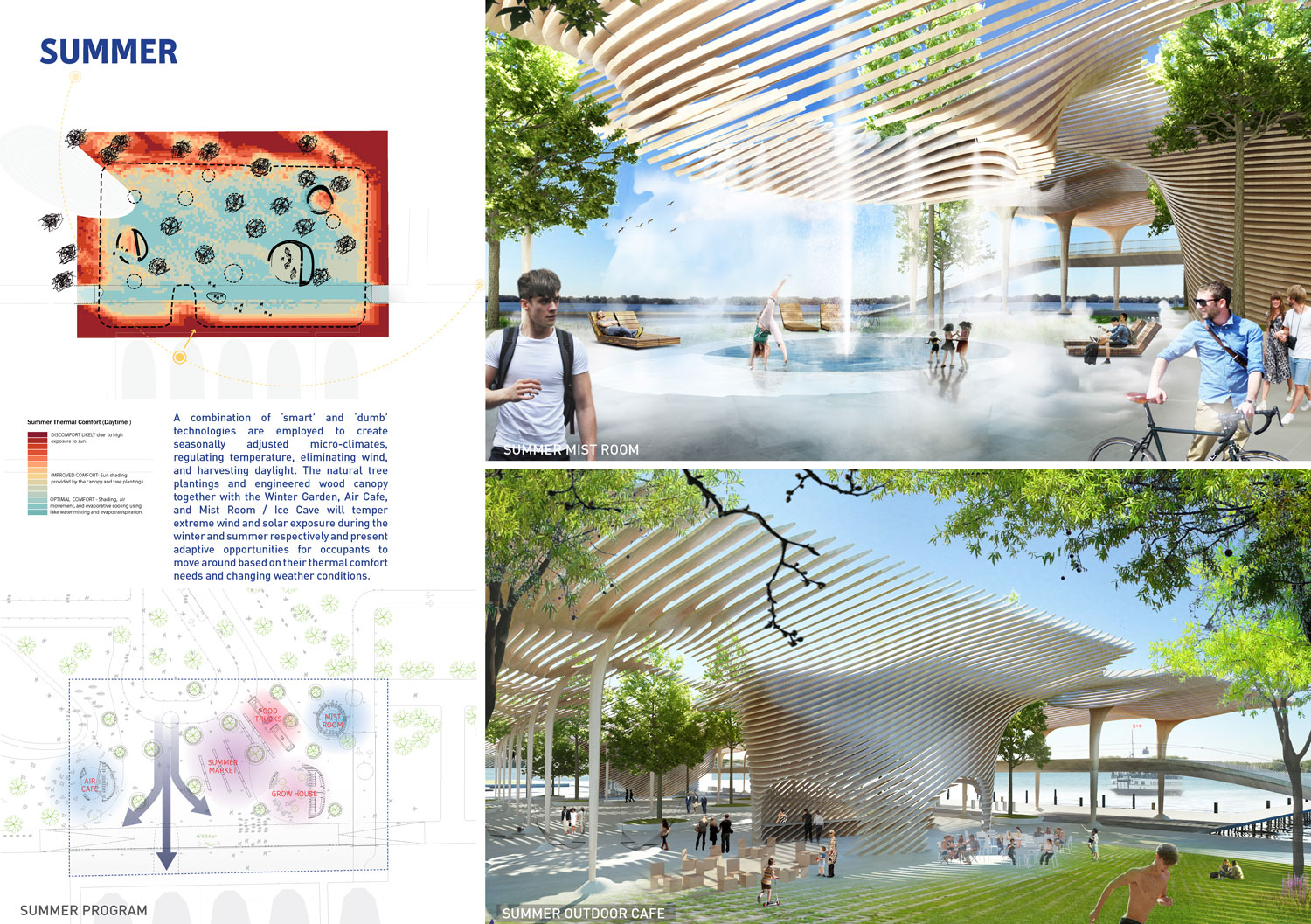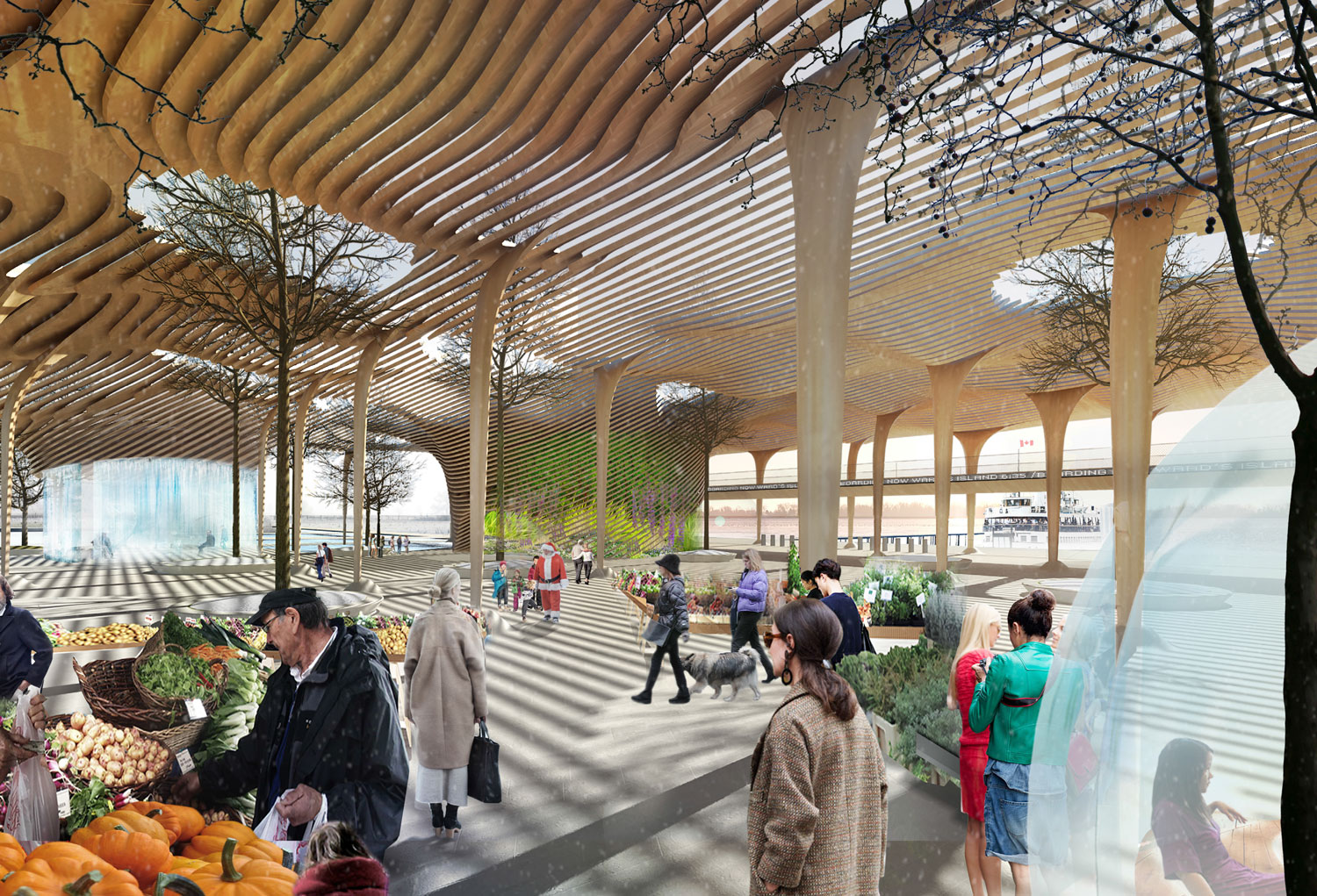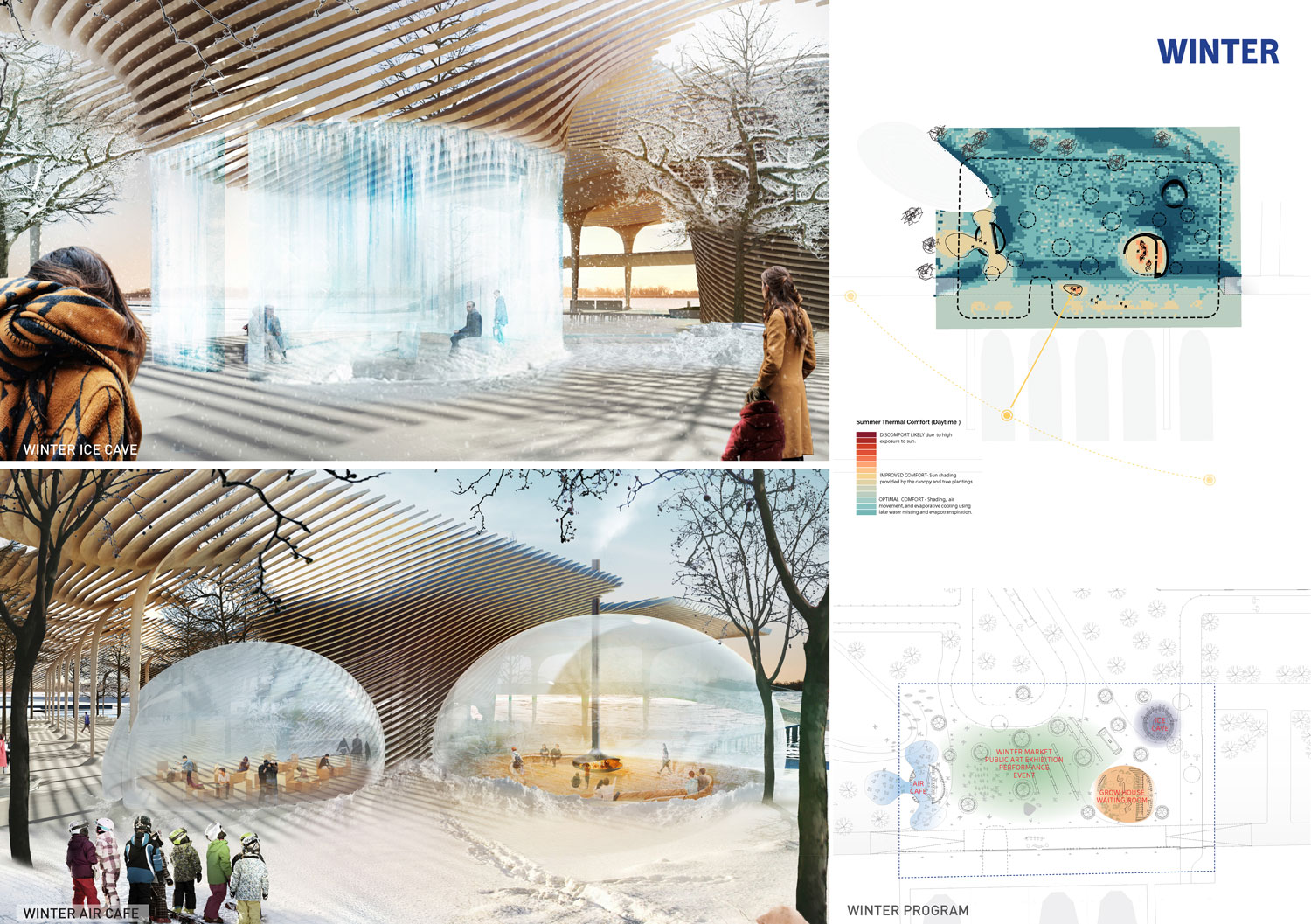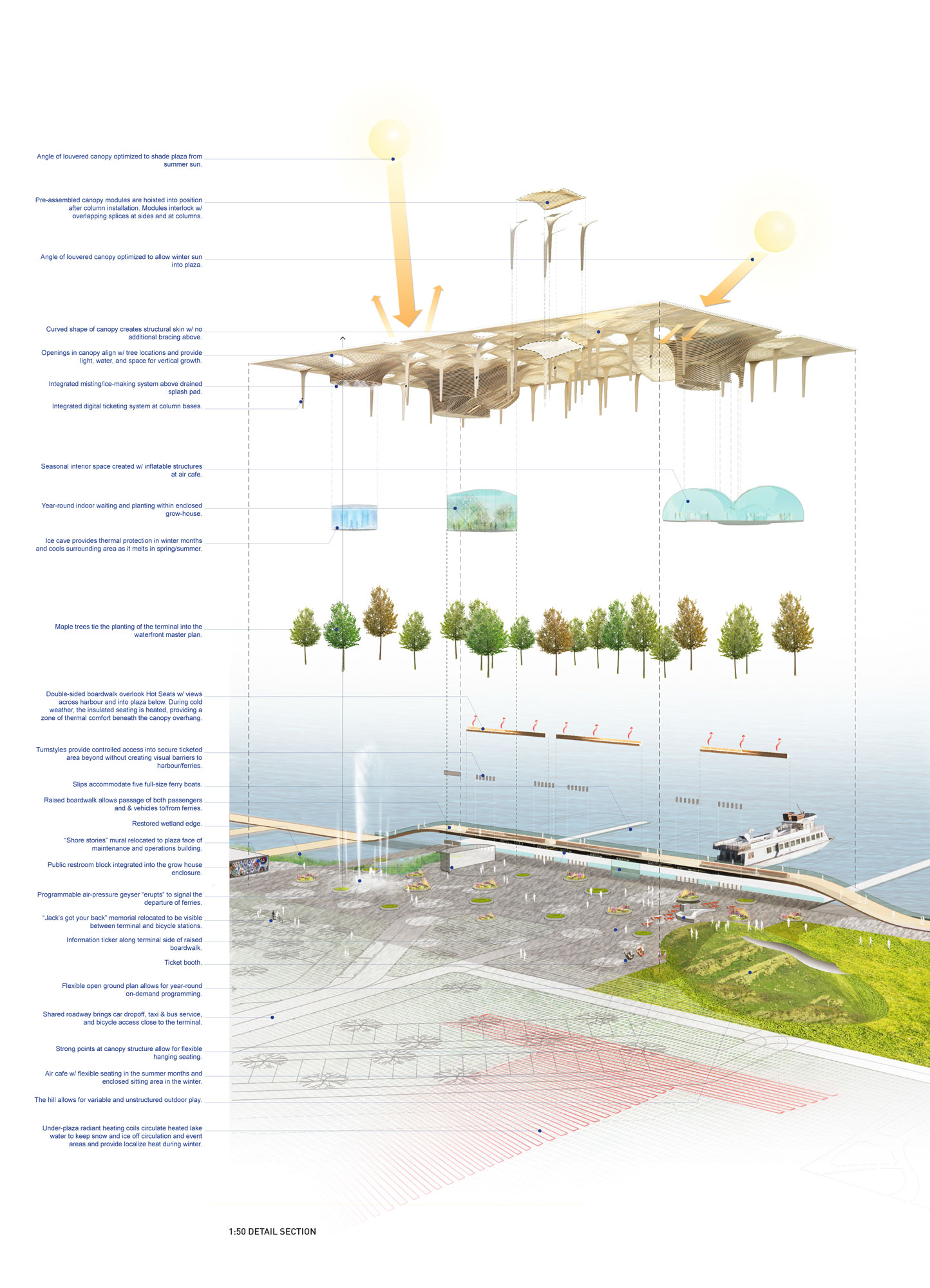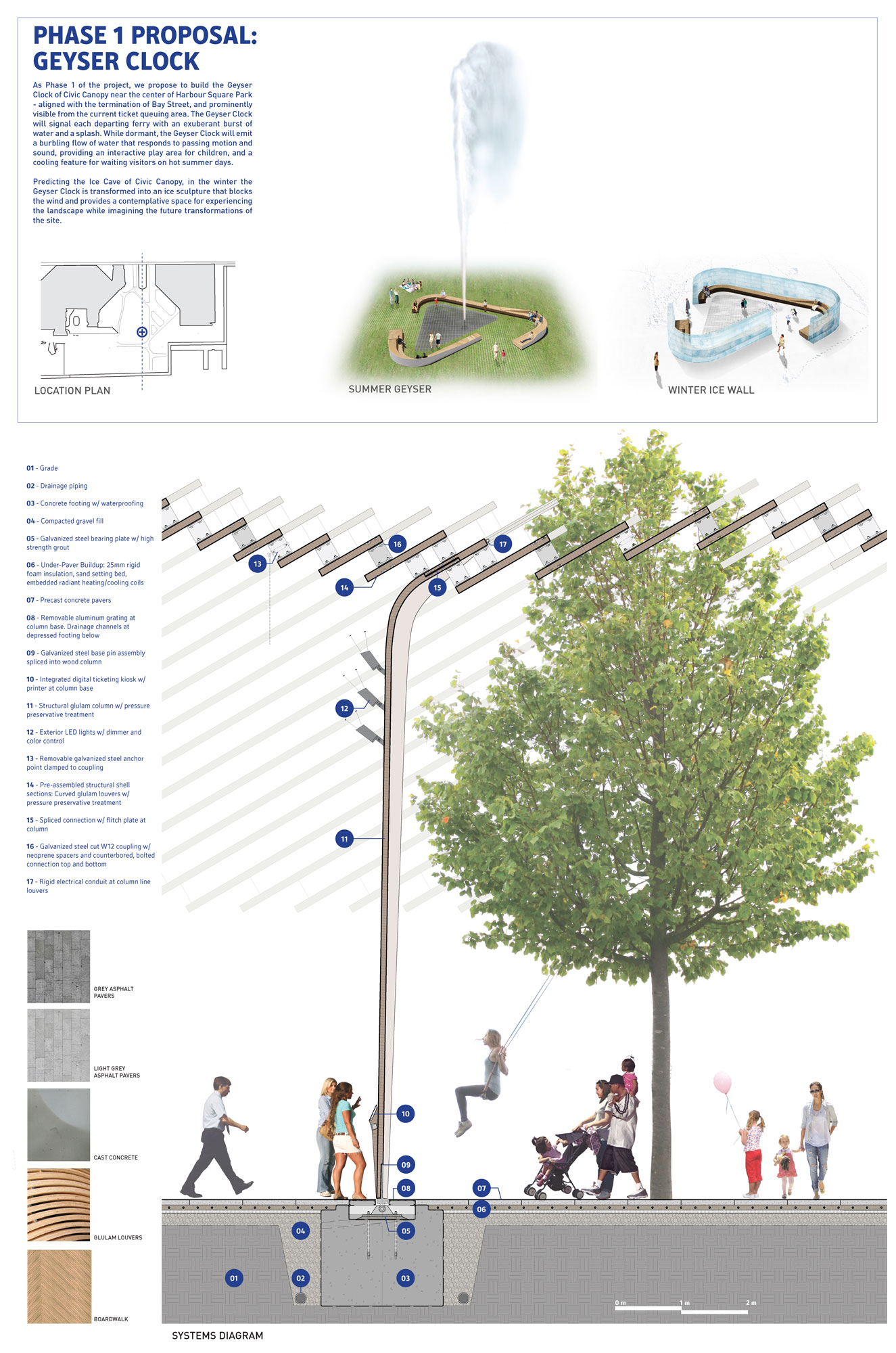1130-DSR-YTZ.CA-2015
Client: Waterfront Toronto
Status: Competition (2015)
Location: Toronto, Canada
Climate: Continental, Temperate
Materials: Wood, Vegetal
Environment: Seaside
Visualizer: Studio
Scale: Extralarge
Types: Masterplan, Port, Public space, Transport
As water has evolved from the city’s industrial workhorse to its aquatic playground and shorelines have changed from mercantile to natural landscapes, cities must invent new civic typologies to fully seize the opportunities at hand. The Jack Layton Ferry Terminal has the potential to be one of Toronto’s most important waterfront civic spaces. What would it be like if constructed, green and aquatic landscapes could merge to form new, hybrid spaces of utility and play, creating a new kind of civic icon — an icon based as much on experience as form, as much on engineered green as man-made material? The new Jack Layton Ferry Terminal and Harbour Square Park can become just that — a ‘soft icon’, reflecting the Toronto of the 21st Century.
Civic Canopy acknowledges the growing diversity of Toronto’s population, engages in the reactivated waterfront with year round, dynamic, ever-changing programming, and provides an innovative structure befitting its position as a centerpiece of urban life. Civic Canopy embodies Jack Layton’s personal and political principles of inclusion, accessibility, equality and enlightened populism. The renewed Harbour Square Park forms a synergistic bond with Civic Canopy, flowing freely under and through the canopy while becoming a unique destination along the city’s waterfront.
Civic Canopy is an open, expansive timber roof that overlays and links greenscape, hardscape, and waterscape, covering the vehicle drop-off, ferry boarding area, park zones and water inlets. Like the tree canopy it intersects, City Canopy offers shade in the summer months and direct sunlight in the winter months. The new roof acknowledges the diurnal shifts in weather and populations, transforming over the year with a series of modifications both spectacular and invisible. Wild swings in temperature are seasonally adjusted with altered climates achieved through latent and active environmental modifications. New programming breathes life into the terminal and park in off seasons. Waiting is transformed from a passive nuisance to active pleasure.
Rather than constantly checking the time, visitors meander freely in the park or warm themselves in the Grow House and are summoned to their ferry by a Geyser Clock, spectacularly erupting in advance of each departure. Civic Canopy warps, bends and breaks to accommodate natural and programmatic features. Trees emerge through its openings, enclosed and conditioned areas are formed through puckers in its surface. The resulting undulating form is both liquid and solid, transparent and opaque, reflecting a merger of water and land. Harbour Square Park samples the native landscapes of the Islands and brings them to downtown Toronto. Naturalistic waterfronts and flora form an enmeshed landscape which is simultaneously constructed and ecological – urban and wild.
A Hybrid Landscape: Harbour + Square + Park
The site of the Jack Layton Ferry Terminal is characterized by a wideranging mix of user groups – ferry riders, local residents, park users, tourists, kayakers – and myriad formal and informal programs, from ferry embarkation to picnics. To accommodate this broad variety of diverse uses within a single landscape that is coherent at the civic scale, suggests a hybridized site strategy. The site must be approached as a fusion of landscape typologies: Harbour and Square and Park.
The city itself emerges from the ‘Harbour’, a protected and sheltered place alongside the Lake Ontario shoreline. Within this context, the water is calmer, the edge is less constructed, and the ecology more diverse. The Harbour offers a transition from the Great Lake; a shift in scale and microclimate. It is possible to relinquish control of the built edge of the city within the Harbour, expanding the existing ‘Park’ outward to cultivate wetlands, beaches, leisure and play areas adjacent to the Harbour.
This landscape is sampled from the Toronto Islands on the south of the side of the Harbour, where the edge and connection to the water typify Torontonians’ aquatic experience. Samples of wetlands, beaches and play spaces bring referential legibility and a flexibility of use throughout the seasons to the new Harbour Square Park landscape.
Harbour Square Park samples the native landscapes of the Islands and brings them to downtown Toronto. Naturalistic waterfronts and flora form an enmeshed landscape which is simultaneously urban and wild. In this way the site acts as both a harbour for different landscape conditions and a harbouring landscape for multiple uses.
Breathing Room
The current Ferry Terminal site no longer supports demand. Its pinched relationship to the Westin Harbour Hotel is the biggest impediment to relieving the congestion and long lines that characterize the experience of embarking to the Toronto Islands today. By moving the terminal south and aligning it with the new boardwalk edge, this structure gains the breathing room it needs to match its density of visitors. By shifting the terminal west to align with Bay Street, the Terminal gains the visibility and integrated relationship with the city befitting its importance to the city of Toronto. Civic Canopy’s new site will allow the terminal to be a thriving and well planned transportation node and civic space for generations to come.
Gateway/Edge
The master plan to connect the pier heads of the Waterfront, linking them together with a grand boardwalk and tree lined promenade, is an inspiring vision that must be extended through the Terminal site. Rather than jogging this public path around the Terminal, we propose to lift the boardwalk off the ground so that ferry passengers may pass beneath it while the public maintains uninterrupted waterfront access. In addition to defining the public edge from which to view the Islands, here, the boardwalk becomes the Island’s gateway.
Common Ground
In order for the new Terminal to be truly civic, it must serve everyone and provide access to all. Pedestrians, bikes, cars, taxis, buses, wheelchairs and strollers, all require direct access. Wheeled vehicles and pedestrians will all share a curb-free, paved environment blurring the boundaries between road, sidewalk and plaza. A significantly widened sidewalk approach from the north and a seamless connection to the waterfront promenade will provide ample space for large summer crowds. By removing the existing suppressed condo access road and extending Bay Street into the site, buses, taxis and other vehicles will be able to drop-off and pick-up visitors in an orderly and efficient manner. Bicycle infrastructure continues to improve in Toronto. So too must bike access to the Toronto Islands, one of the great biking areas of the city. The new Queens Quay bike lane will extend into Harbour Square Park and under the Civic Canopy. Bike parking and a Bike Share Toronto station will find a prominent and shaded place within a grove of trees.
Terminal Outlook
Once outliers, standing apart from the city at the water’s edge, the Westin Harbour Hotel and Harbour Square condominium complex are on now the verge of being absorbed into Toronto’s urban fabric. Yet these buildings and their landscape features continue to form a physical and conceptual barricade to the water. To reconnect this part of the city to the water, the current hill, hole and bridge at the foot of Bay Street are removed and replaced by a spacious at grade entry experience with a continuous uninterrupted view to the new Ferry Terminal and lake beyond.
